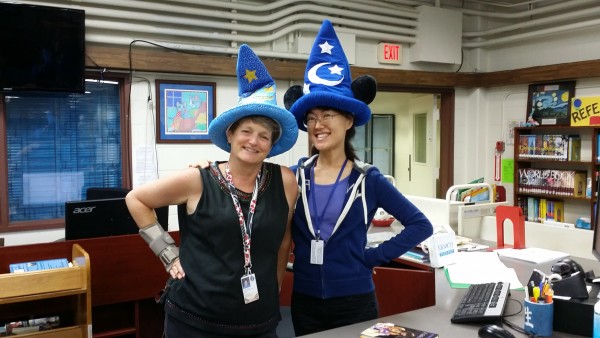2018 School Spending Survey Report
An American Library in Seoul, South Korea | A View from Abroad
It's back to school for a group of young Americans in Seoul, South Korea.

Library Information Specialists Barb Kuttler and Linda Chin at the SAES Library in Seoul, South Korea
From Barbara Kuttler, Library Information Specialist at the Seoul American Elementary School, South Korea: Korea was once known as the Hermit Kingdom due to its isolation from the West prior to the latter half of the 19th century. This moniker is still used by some to refer to North Korea, but South Korea is one of the most connected countries of the world. I am glad to report that the approximately 1,100 students at the Seoul American Elementary School (SAES), located on United States Army Garrison, or USAG Yongsan, are enthusiastic readers and library users, to the tune of checking out roughly 38,000 books a year. Preschool through fifth grade classes come to the library for lessons or read-alouds and are provided with time to borrow books for leisure reading and curricular support. Our students are the children of members of the US military and Department of Defense civilian workers and contractors; English is the language of instruction, and we follow American standards and curriculum. They are very diverse ethnically; many languages besides English are spoken at home, and many children have more stamps in their passports than most American adults. Though students also use their Kindles and other devices to access books, they love coming to our library weekly (or more often) to read their favorite authors, and find information on topics they find interesting (animals, gemstones, dinosaurs, and military vehicles, rank high). The Army has plans to move most of its operations to USAG Humphreys in Pyeongtaek, South Korea, so fellow library information specialist, Linda Shin, and I will need to make decisions about what library resources will be going. As Seoul AES Library has been serving the children of the US military in South Korea since the 1960s, I suspect much of our collection won't pass muster—our students read books until they are falling apart. As we begin the new school year, we will have a big map of the world on display for students to mark where they have been over the summer, or where they traveled in their reading. Perhaps as a tip of our hat to Pokémon GO, we'll let students choose a Pokémon character sticker as their avatar.
Linda Shin, Library Information Specialist, teaching a lesson in traditional dress. SAES Library in Seoul, South Korea
From Robyn Gioia, SAES 5th grade teacher and School Library Journal reviewer: As a teacher at SAES, the library is a key resource in educating my students. Our weekly visits introduce students to genres, award winners, new books, and a variety of thematic topics, as well as how to access books and information sources in our catalog and online. Last year, Barb taught the students a terrific lesson on the classics. For many of the students, it was their first exposure to a number of these authors and books; they were amazed at the number of these stories they already knew, but that they did not realize were originally books. Each student chose a classic to read, and their culminating projects exposed their classmates to many additional titles. At the conclusion of their presentations, a class discussion revealed a delight in discovering what enduring elements had made these titles “classics." Each year, it’s my goal to turn my students into avid readers. Together we explore different genres, formats, and writing styles, and discuss what we find exciting about them. A daily, post-recess read-aloud offers an opportunity to consider comprehension questions, but writing techniques, such as “show, don’t tell,” are also examined so students can understand an author’s decisions. I often tell students that reading teaches us how to write because it exposes us to correct sentence structure over and over again. My strongest writers are always avid readers. Students’ fiction selections run the gamut, but they especially love series; they can’t get enough of them. J. K. Rowling’s “Harry Potter,” Liz Kessler’s “Phillipa Fisher Fairy” stories, and Erin Hunter’s “Warrior” series are particularly in high demand. Each year my class tends to have a special interest. Last year Greek mythology was the theme. Students checked out every Rick Riordan book and anything they could find on the gods and goddesses. Conversations about mythology were daily occurrences in the classroom. Between our library visits and class assignments, and their pursuit of personal interests, many of these readers have proudly earned the “bookworm” title.RELATED
RECOMMENDED
CAREERS
The job outlook in 2030: Librarians will be in demand
CAREERS
The job outlook in 2030: Librarians will be in demand
ALREADY A SUBSCRIBER? LOG IN
We are currently offering this content for free. Sign up now to activate your personal profile, where you can save articles for future viewing






Add Comment :-
Be the first reader to comment.
Comment Policy:
Comment should not be empty !!!